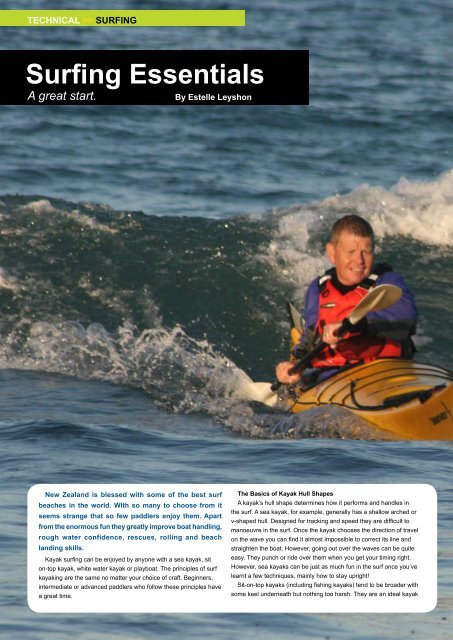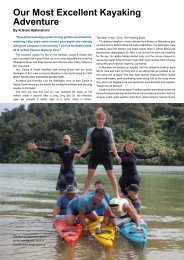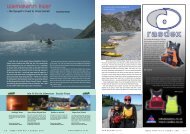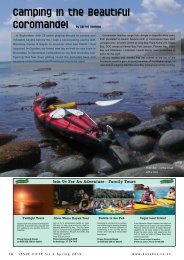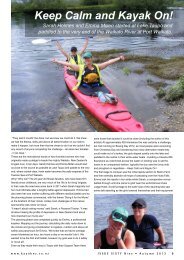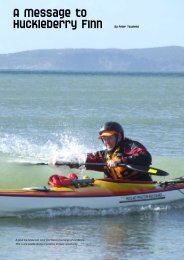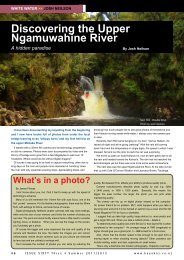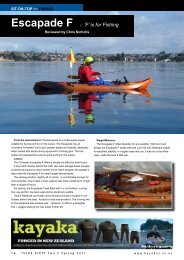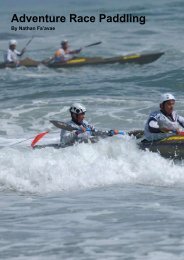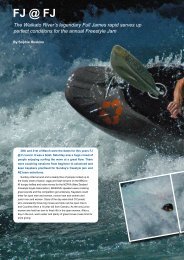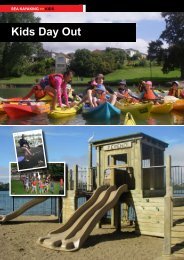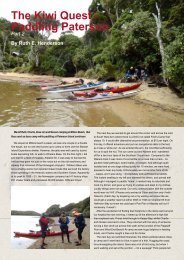Surfing Essentials - New Zealand Kayak Magazine
Surfing Essentials - New Zealand Kayak Magazine
Surfing Essentials - New Zealand Kayak Magazine
You also want an ePaper? Increase the reach of your titles
YUMPU automatically turns print PDFs into web optimized ePapers that Google loves.
TECHNICAL >> SURFING<br />
<strong>Surfing</strong> <strong>Essentials</strong><br />
A great start.<br />
By Estelle Leyshon<br />
<strong>New</strong> <strong>Zealand</strong> is blessed with some of the best surf<br />
beaches in the world. With so many to choose from it<br />
seems strange that so few paddlers enjoy them. Apart<br />
from the enormous fun they greatly improve boat handling,<br />
rough water confidence, rescues, rolling and beach<br />
landing skills.<br />
<strong>Kayak</strong> surfing can be enjoyed by anyone with a sea kayak, sit<br />
on-top kayak, white water kayak or playboat. The principles of surf<br />
kayaking are the same no matter your choice of craft. Beginners,<br />
intermediate or advanced paddlers who follow these principles have<br />
a great time.<br />
The Basics of <strong>Kayak</strong> Hull Shapes<br />
A kayak’s hull shape determines how it performs and handles in<br />
the surf. A sea kayak, for example, generally has a shallow arched or<br />
v-shaped hull. Designed for tracking and speed they are difficult to<br />
manoeuvre in the surf. Once the kayak chooses the direction of travel<br />
on the wave you can find it almost impossible to correct its line and<br />
straighten the boat. However, going out over the waves can be quite<br />
easy. They punch or ride over them when you get your timing right.<br />
However, sea kayaks can be just as much fun in the surf once you’ve<br />
learnt a few techniques, mainly how to stay upright!<br />
Sit-on-top kayaks (including fishing kayaks) tend to be broader with<br />
some keel underneath but nothing too harsh. They are an ideal kayak
to use if you are a novice in the surf. They build confidence since<br />
there is no fear of entrapment. If you do fall out they do not fill up<br />
with water like sit-in kayaks. Therefore, they can be easier to recover<br />
in the surf than other craft but still tricky to climb back on when the<br />
swells are coming through. Because of their hull design they tend to<br />
be much more stable than sea kayaks and white water kayaks. They<br />
allow a little bit of manoeuvrability so you can still have fun catching<br />
the waves.<br />
Those with flatter, planing hulls (like playboats and white water<br />
kayaks) lend themselves better to kayak surfing as they have fast<br />
hulls and are manoeuvrable. The paddler can carve and turn and<br />
even do tricks on the wave. The downside to these is that they can’t<br />
always punch through the waves and unless you perfect a ‘dip and<br />
roll’ technique, you can find yourself picked up and dumped by the<br />
waves. However, once you have the confidence, these kayaks are<br />
the choice of many on the surf. They can be marvellous fun.<br />
If you truly want to master kayak surfing then a full ‘surf kayak’ is<br />
the ultimate weapon of choice. Designed with hulls like surf boards,<br />
including tri-fins, these kayaks can gather incredible speed down<br />
a wave with edges (or rails as they’re known) that simply carve up<br />
the wave. These kayaks are not for the novice and can be unstable<br />
and difficult to roll but if mastered correctly they become a thing of<br />
beauty on the water.
The Basic Principals of <strong>Kayak</strong> <strong>Surfing</strong><br />
Now that you understand a little about hull shapes, consider which<br />
category your kayak fi ts in to?<br />
With any kayak, the better the fit, the more control you will have<br />
on the waves. For those with sit-on kayaks invest in a pair of thigh<br />
braces that simply clip on to your boat. These just sit over your knees<br />
and will give you better hip control, which you’ll learn is important in surf.<br />
If you capsize they fall off when you drop your knees. So there is little<br />
risk of being connected to your boat when capsizing. I meet so many<br />
kayak fi shermen who have never used them and when shown what they<br />
do it’s always the next thing they purchase. Besides it helps to keep<br />
belongings and dignity intact!<br />
With your kayak set up correctly, approach the water, watch<br />
and wait. A common reason people tip out of their kayaks<br />
is nervous haste to get out through the surf. They fail to<br />
watch the patterns and frequency of the waves. Waves<br />
tend to come in sets, a succession of larger waves followed<br />
by a succession of smaller waves. Watch several sets<br />
come through so you get a better idea of the frequency.<br />
Timing is everything, and when a large set of waves has<br />
just fi nished you need to be heading out for an easier ride<br />
through breaking waves and surf. Ideally head directly into<br />
the oncoming waves at 90 degrees. Keep paddling: don’t<br />
stop every time a wave comes towards you. You need to keep<br />
forward momentum to get over the waves. This is much safer<br />
than being picked up and carried backwards by a wave. Don’t<br />
stop paddling until you are beyond the break zone in swells with<br />
no breaking waves. Here you can rest and position yourself safely<br />
until you are ready to catch a wave.<br />
Beginners are advised to start off in the white wash of the broken<br />
waves to get a feel for it.<br />
Catching your fi rst wave, be it big or small, can be one of the most<br />
exhilarating experiences. However, for too many the experience is short<br />
lived. They get tipped over just as they were gaining speed, clueless<br />
why it happened.<br />
Firstly, when they do pick a wave they often leave it too late to pick up<br />
the same pace as the wave. This means they will either be dumped on<br />
the wave, or catch the wave and then gain sudden speed which they<br />
can’t control and ‘pearl’ or nose dive the kayak. Or they miss the wave<br />
altogether as it travels past them. You will be more successful and<br />
safer if you ensure that you get up to the same speed as the wave<br />
before catching it. This means paddling hard in advance of the wave.<br />
By doing so, the kayak will glide down the wave and stay ahead of it.<br />
If whilst on the wave you feel the kayak slow, lean forwards and put in<br />
some more paddle strokes to speed up.<br />
Secondly, people tip over when they feel the kayak start to turn.<br />
The human instinct is to try to correct this turn by straightening the<br />
kayak and in doing so they lean in the opposite direction (away from<br />
the wave). By leaning away from the wave, the water that is rising up<br />
the wave will catch the bottom edge of the kayak and fl ip you over. So<br />
when catching any wave, big or small, it is always important to lean<br />
into the wave, edging your kayak as much as possible. This will<br />
give you stability and control on the<br />
wave. When you are learning<br />
and your kayak starts to turn,<br />
go with it and concentrate on<br />
leaning and edging your kayak<br />
into the wave. By adding<br />
a support stroke with your<br />
paddle and literally bracing<br />
yourself on the wave you will<br />
get even more stability.<br />
Just remember that as<br />
the power of the wave<br />
dissipates you need to<br />
relax your edging and<br />
transfer your weight<br />
to the centre<br />
of the kayak<br />
Above: As a beginner, it’s often fun to<br />
otherwise<br />
let the kayak run down the wave with no<br />
you can fi nd<br />
paddle control. To get control, put your<br />
paddle blade as a rudder at the rear of<br />
yourself tipping<br />
the kayak. This will control your decent over the other<br />
on the wave.<br />
way.<br />
Commonly,<br />
I see people<br />
leaning<br />
backwards<br />
in the kayak as they come down a wave, either thinking it will keep<br />
the bow of the kayak up or as a human instinct that tries to get them<br />
away from the possible danger of the water in front of them. In leaning<br />
backwards you are in fact slowing the kayak down. By leaning forwards<br />
Join Us For A <strong>Kayak</strong>ing Adventure - River Tours<br />
River Tours Mokau River White Water Paddling Waitara River Tours<br />
Exploring beautiful estuaries.<br />
Enjoy a scenic trip with wildlife and wonderful<br />
views.<br />
Enjoy this beautiful scenic river which<br />
winds through some of <strong>New</strong> <strong>Zealand</strong>’s<br />
lushest vegetation. Camping overnight and<br />
exploring some of <strong>New</strong> <strong>Zealand</strong>’s pioneering<br />
history. A true Kiwi experience.<br />
Need some excitement? Take a kayak down<br />
a wicked Grade Two river run... this is a<br />
whole day of thrills and fantastic scenery<br />
down some of <strong>New</strong> <strong>Zealand</strong>’s best rivers.<br />
For those who are slightly more adventurous at<br />
heart, this is a scenic trip with the excitement<br />
of Grade Two rapids. Midway down, we<br />
paddle under the historic Betran Road<br />
Bridge where we will stop for a snack.<br />
Phone Canoe & <strong>Kayak</strong><br />
on 0508 529 2569 for details<br />
Phone Canoe & <strong>Kayak</strong><br />
06 769 5506<br />
Phone Canoe & <strong>Kayak</strong><br />
on 0508 529 2569 for details<br />
Allow 2 hours paddle only.<br />
Priced at $70.<br />
Phone: 06 769 5506<br />
30 ISSUE SIXTY Four • Autumn 2012 www.kayaknz.co.nz
you will gain more speed, which puts the kayak in a better position<br />
on the wave. A top tip is that if you think your kayaks’ bow is<br />
going to dip down in to the wave, simply edge and turn your<br />
kayak more into the wave. This will prevent a kayak from<br />
‘pearling’.<br />
For those just wanting to make the beach landing as simple and<br />
dry as possible, without the thrill of catching a wave or too many<br />
of them, then it is very important to sit out at the back of the waves<br />
and watch the pattern of the waves. When the last big wave of<br />
the big set comes through, paddle right behind it on the back of<br />
the wave. Keep paddling until you reach the beach and remove<br />
yourself from the kayak as quickly as possible. Be ready to edge<br />
and apply a support stroke if necessary. Some fi nd coming in on a<br />
wave backwards easier as they can see what’s coming and slow<br />
themselves down by paddling against the waves. This can take a<br />
little practice!<br />
Essentially, ‘practice’ is the key. Be prepared to get wet and lose<br />
your dignity a little. Start on small broken waves and then build up<br />
your confi dence and technique before moving to more challenging<br />
green waves. Try a sit-on fi rst if you’re really nervous and then<br />
progress to a sit-in. Whichever way you do it you will discover<br />
how much fun you were missing and that it wasn’t as scary as you<br />
thought. You’ll be a much better paddler for it!<br />
Get kayak surfi ng with Canoe & <strong>Kayak</strong> who offer courses for all<br />
abilities. See www.canoeandkayak.co.nz for more details.


